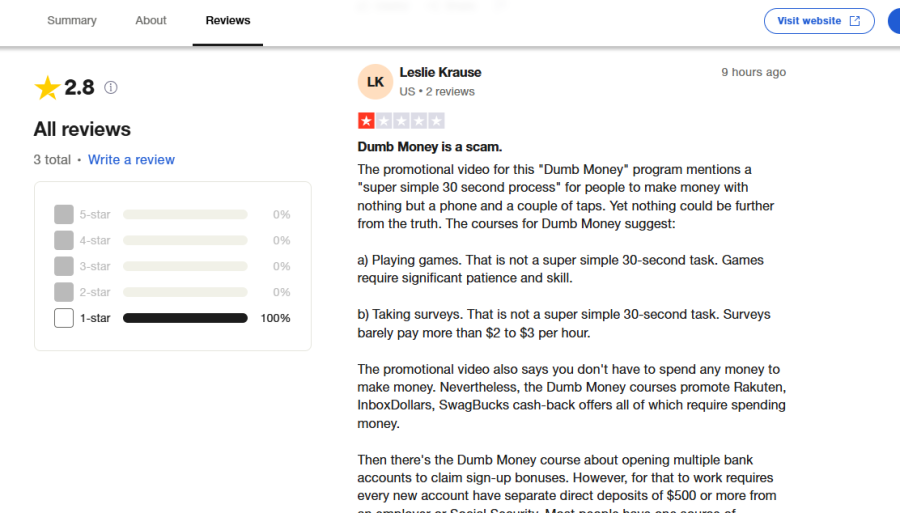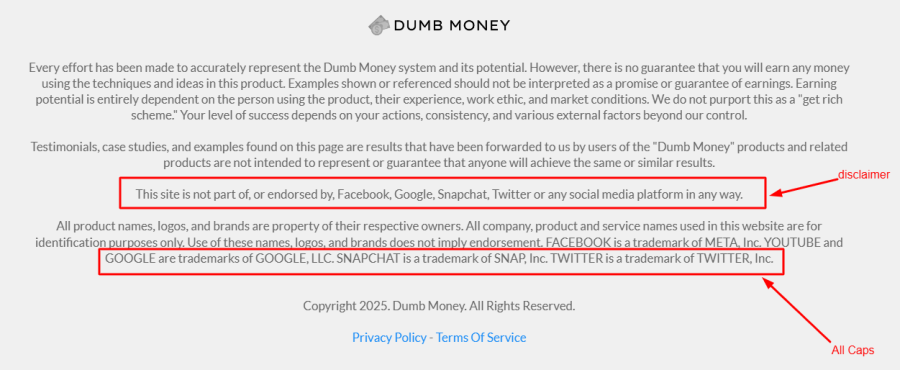Is GetDumbMoney.com Legit or a Scam? Here's What You Need to Know

Author: Adam Collins
Let’s face it—if someone told you there’s a website where you could earn thousands of dollars a month by doing 30-second tasks on your phone, you’d at least be curious. And that’s exactly how GetDumbMoney.com gets your attention. It promises quick, easy cash for “bite-sized tasks” and even flaunts a guy named Matt Scott who claims he’s raking in $10,000 a month from it. Sounds too good to be true? That’s because it probably is.
Here’s a closer look at what’s really going on behind GetDumbMoney.com—and why you should think twice before signing up.
What Is GetDumbMoney.com Promising?
The website markets itself as a money-making opportunity that’s fast, easy, and perfect for beginners. Supposedly, all you have to do is complete simple tasks—no experience needed—and the money will roll in. In a promotional video that’s been making the rounds online, Matt Scott breaks down the “3 simple tricks” he uses to cash in.
There’s just one catch: to access the secret formula, you need to pay.
Why Are They Charging You to Make Money?
One of the biggest red flags is the upfront cost. GetDumbMoney.com asks for a one-time payment of $67 (conveniently “discounted” from $97). But if the system really works so well, why are they charging you in the first place?

The idea of paying to learn how to make money isn’t inherently wrong—but in most legitimate cases, you’re paying for education, not promises of instant riches. With GetDumbMoney, the focus seems more on urgency and hype than on substance.
They even use scare tactics, like warning that “the system might be discovered by big corporations,” implying that this is some underground hack you should jump on right now. It’s a classic pressure move—act fast or miss out!
What Real Users Are Saying
A quick look at Trustpilot and other review sites reveals a flood of negative feedback. Many users describe the platform as misleading and full of empty promises. Here are some highlights from real reviews:
- “Dumb Money claims you can make money in 30 seconds with just your phone—but that’s false.”
Reviewers say the methods involve time-consuming activities like downloading apps, playing games, completing surveys, or using cashback offers that require you to spend money before you earn anything.

- “Should be called GetDumb PEOPLE'S money.com.”
One particularly scathing review calls out Matt Scott for presenting himself as an “instructor,” while delivering a series of low-quality videos with outdated money-making advice. No quick wins, no $30 surveys, and definitely no instant payouts.

Is It Just Reverse Psychology?
The site also uses sneaky tricks that are common in scam websites. For example, at the bottom of the page, it boldly claims:
“This site is not part of, or endorsed by, Facebook, Google, Snapchat, Twitter…”

While that might sound like a standard disclaimer, the all-caps branding of those platforms makes them stand out—drawing your attention rather than deflecting it. It feels intentional, almost like a subtle nod to legitimacy.
So, Is GetDumbMoney.com a Scam?
Overall, there are plenty of red flags that suggest GetDumbMoney.com is risky.
Key Warning Signs:
🚩 You must pay upfront to access the “system”
🚩 Over-the-top income claims with no proof
🚩 Vague details about what the tasks actually involve
🚩 Scare tactics and urgency tricks
🚩 Overwhelmingly negative customer reviews
🚩 Outdated, recycled content in the training videos
🚩 Delays in payouts and no evidence of real earnings
Final Verdict
GetDumbMoney.com plays heavily on hype and hope, but the reality seems far less rewarding. If you're looking to make money online, there are more transparent, reputable ways to do it, like the 15 legit online job sites, without handing over cash for promises that don’t deliver.
Sometimes the easiest money is the hardest lesson.
This article has been written by a scam fighter volunteer. If you believe the article above contains inaccuracies or needs to include relevant information, please contact ScamAdviser.com using this form.
Report a Scam!

Have you fallen for a hoax, bought a fake product? Report the site and warn others!
Scam Categories
Help & Info
Popular Stories
As the influence of the internet rises, so does the prevalence of online scams. There are fraudsters making all kinds of claims to trap victims online - from fake investment opportunities to online stores - and the internet allows them to operate from any part of the world with anonymity. The ability to spot online scams is an important skill to have as the virtual world is increasingly becoming a part of every facet of our lives. The below tips will help you identify the signs which can indicate that a website could be a scam. Common Sense: Too Good To Be True When looking for goods online, a great deal can be very enticing. A Gucci bag or a new iPhone for half the price? Who wouldn’t want to grab such a deal? Scammers know this too and try to take advantage of the fact. If an online deal looks too good to be true, think twice and double-check things. The easiest way to do this is to simply check out the same product at competing websites (that you trust). If the difference in prices is huge, it might be better to double-check the rest of the website. Check Out the Social Media Links Social media is a core part of ecommerce businesses these days and consumers often expect online shops to have a social media presence. Scammers know this and often insert logos of social media sites on their websites. Scratching beneath the surface often reveals this fu
So the worst has come to pass - you realise you parted with your money too fast, and the site you used was a scam - what now? Well first of all, don’t despair!! If you think you have been scammed, the first port of call when having an issue is to simply ask for a refund. This is the first and easiest step to determine whether you are dealing with a genuine company or scammers. Sadly, getting your money back from a scammer is not as simple as just asking. If you are indeed dealing with scammers, the procedure (and chance) of getting your money back varies depending on the payment method you used. PayPal Debit card/Credit card Bank transfer Wire transfer Google Pay Bitcoin PayPal If you used PayPal, you have a strong chance of getting your money back if you were scammed. On their website, you can file a dispute within 180 calendar days of your purchase. Conditions to file a dispute: The simplest situation is that you ordered from an online store and it has not arrived. In this case this is what PayPal states: "If your order never shows up and the seller can't provide proof of shipment or delivery, you'll get a full refund. It's that simple." The scammer has sent you a completely different item. For example, you ordered a PlayStation 4, but instead received only a Playstation controller. The condition of the item was misrepresented on the product page. This could be the
